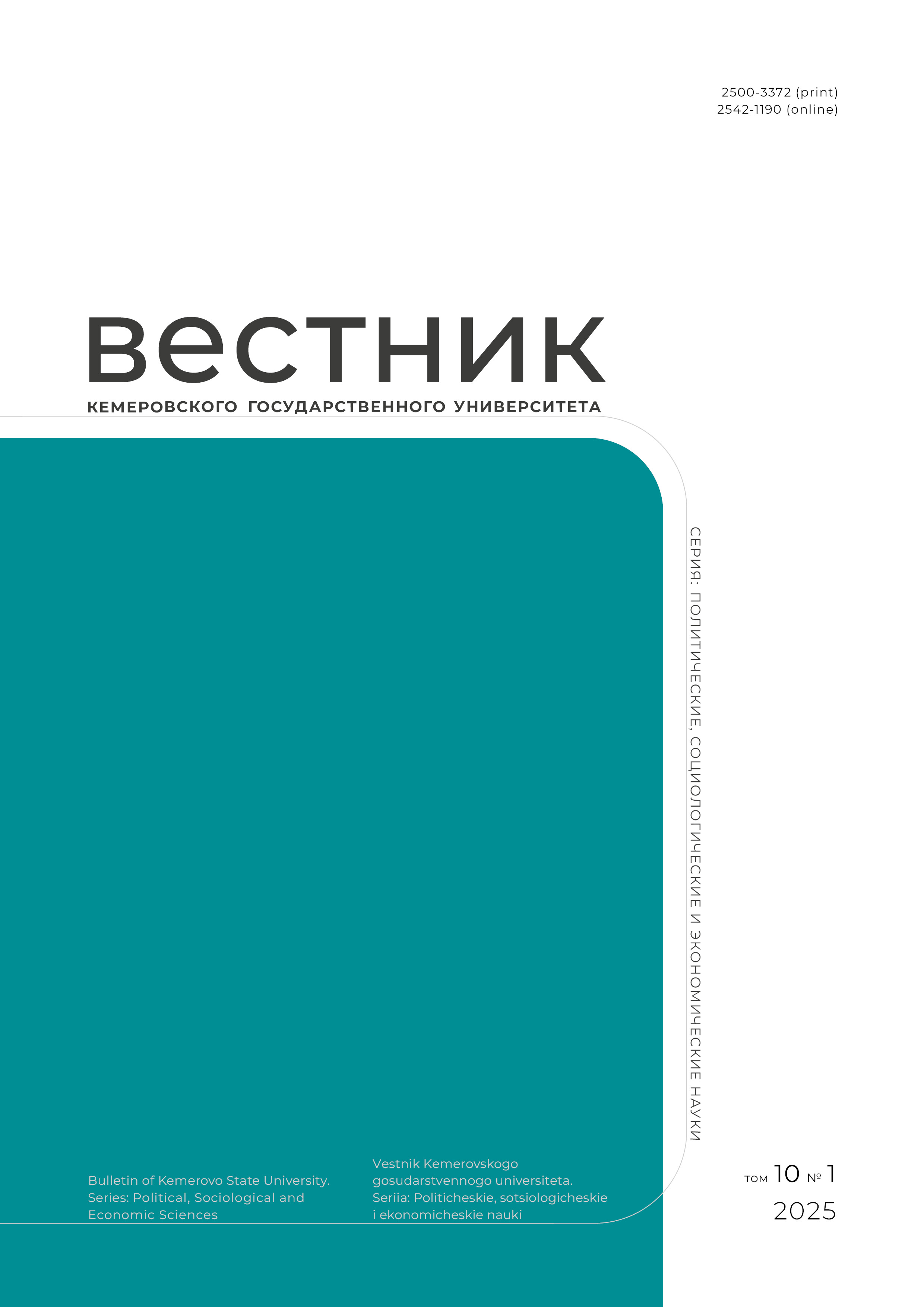Irkutsk, Russian Federation
UDC 33
The aim of the present research was to define the place of Siberia in the current Chinese concept of the Silk Road Economic Belt. The paper features the current state, potential benefits, and possibilities of integrating Siberia into the concept of the Silk Road Economic Belt. An analysis of the commodity structure of exports to China showed that the increasing capacity of transport routes and new highways will strengthen the export and resource role of Siberia. The process is bound to increase deforestation and the export of raw materials to China, especially in the absence of large-scale investments into industrial production. The authors questioned representatives of the Chinese delegation on the economic image of Siberia in China, the future of the bilateral economic interaction, and the needs of the Chinese economy. The concept of local economy proved beneficial on the municipal scale, while the New Angarstroy project will develop production enterprises in Siberia on the national scale, which will meet domestic demand and boost export to China. The Silk Road Fund, established within the Silk Road Economic Belt, and the Russian-Chinese Regional Development Investment Fund can be effectively used as material and financial resources for the economic development of Siberia. They can provide investment in infrastructure and enterprises that will be repaid in the medium and long term.
transport corridor, economic development of Siberia, the Silk Road Fund, regional development, geoeconomics, Russian-Chinese relations
1. Lachininskii S. S. Some aspects of economic security of St. Petersburg and the Leningrad region under conditions of geo-economic uncertaint. Balt. Reg., 2018, 10(3), 136-149. (In Russ.) DOI:https://doi.org/10.5922/2079-8555-2018-3-8
2. Russia and China: four centuries of interrelations. History, modern state, and perspectives of development of Russian-Chinese relations, ed. Lukin A. V. Moscow: Ves Mir, 2013, 704. (In Russ).
3. Dyatlov V. I. Exotisation and "the enemy image": the syndrome of "yellow peril" in pre-revolutionary Russia. Idei i idealy, 2014, 1(2): 23-41. (In Russ).
4. Berger Ya. M. Economic strategy of China. Moscow: Forum, 2009, 560. (In Russ).
5. Bezrukov L. A. The geographical implications of the creation of "Greater Eurasia". Geografiia i prirodnye resursy, 2018, (4): 5-14. (In Russ).
6. Shuper V. A. Transport factor of Russia's movement to east and formation of the greater Eurasia. Regionalnye issledovaniya, 2018, (2): 131-138. (In Russ).
7. Pirozhkova S. V., Zadorozhnyuk I. E., Lepsky V. E. The promising vectors in Greater Eurasia. Vestnik Rossiskoj akademii nauk, 2018, 88(9): 843-847. (In Russ). DOI:https://doi.org/10.31857/S086958730001699-6
8. Vardomsky L. B. Reflections about the Greater Eurasia. Mir peremen, 2018, (3): 187-189. (In Russ.)
9. Piniugina E. V. Russia's role in the formation of the Eurasian interstate transport projects. Rossiya i sovremennyj mir, 2018, (1): 157-171. (In Russ).
10. Uyanaev S. V. The PRC's "One belt, one road" initiative: evolution, documents and view from Russia. The New Silk Road and its significance for Russia, ed. Petrovsky V. E. Moscow: DeLi plius, 2016, 11-37. (In Russ).
11. Batomunkuev V. S., Dong S., Lubsanova N. B. Investigation of the possibility for constructing China-Mongolia-Russia high-speed railway and its impact on the transboundary territory. BSU bulletin. Economics and management, 2017, (2): 35-39. (In Russ.) DOI:https://doi.org/10.18101/2304-4446-2017-2-35-39
12. Sherin E. A. Geographical destinations and scale of the Siberian coals export. ECO, 2018, (8): 148-160. (In Russ.)
13. Fartyshev A. N. Irkutsk region in the conception "Silk Road" Economic Belt. The Bulletin of Irkutsk State University. Series Political Science and Religion Studies, 2018, 26: 37-45. (In Russ). DOI:https://doi.org/10.26516/2073-3380.2018.26.37
14. Ganzey S. S. Transborder geosystems of South of Far East and the Northeast of China. Vlasovostok: Dalnauka, 2004, 230. (In Russ).
15. Aguirrechu A. A., Mironenko K. V. Economic-geographical study of China in domestic geographical literature. Izvestiya Russkogo geograficheskogo obschestva, 2019, 151(3): 73-93. (In Russ). DOI:https://doi.org/10.31857/S0869-6071151373-93
16. Bezrukov L. A., Blanutsa V. I., Nikolsky A. F., Tarakanov M. A., Fartyshev A. N., Sherin E. A. The main tasks of justification of roles and functions of Irkutsk region in the deal of formation benefitial integration of Chinese and Russian economies. Relevant issues of the science of Baikal, eds. Bychkov I. V., Kazakov A. L. Irkutsk: Izd-vo In-ta geografii im. V. B. Sochavy SO RAN, 2017, iss. 2, 26-31. (In Russ).
17. Myadzelets A. V., Vladimirov I. N. International geographical conference "Economic corridor "China-Mongolia-Russia" geographical and ecological factors and possibilities of spatial development". Geografiia i prirodnye resursy, 2019, (1): 194-195. (In Russ.)
18. Fartyshev A. N. Geopolitical and geoeconomical concepts of development and positioning of Siberia: actual vectors and implementation assessment. Multivectorness in the development of Russian regions: resources, strategies, and new trends, ed. Streletsky V. N. Moscow: IP Matushkina I. I., 2017, 291-301. (In Russ.)
19. Dets I. A. Project approach in spatial development: Baikal region. Novosibirsk: Geo, 2018, 139. (In Russ). DOI:https://doi.org/10.21782/B978-5-6041445-0-3
20. Tyurin G. V. Experience of development of China from the point of view of local economy. Economic Strategies, 2016, 18(6): 76-83 (In Russ).
21. Nikolsky A. F. "Novyi Angarstroi" as the key project of future industrialization in Russia. Geografiia i prirodnye resursy, 2017, (4): 143-153. (In Russ). DOI:https://doi.org/10.21782/GIPR0206-1619-2017-4(143-153)
22. Nikolsky A. F., Bezrukov L. A., Shupletsov A. F. "Novyi Angarstroi" as a project of non-raw materials integration of economies of Russia and China. Izvestiya Baikal’skogo gosudarstvennogo universiteta, 2018, 28(3): 470-480. (In Russ.) DOI:https://doi.org/10.17150/2500-2759.2018.28(3).470-480
23. Nikolsky A. F. Shupletsov A. F. The XXI century balance wheel: organization of the largest metallurgical production based on ores of the Chiney and Malotagul deposits. Izvestiya Baikal’skogo gosudarstvennogo universiteta, 2018, 28(1): 44-55. (In Russ.) DOI:https://doi.org/10.17150/2500-2759.2018.28(1).44-55
24. Wu B. Silk Road fund: main direction and results of activity. Economy and business: theory and practice, 2018, (5-2): 134-142. (In Russ.)
25. Savkovich Y. V., Markova D. S. Chinese-Russian investment cooperation within "One Belt and One Road" initiative. Izvestiia Ural federal university. Series 3. Social and political sciences, 2018, 13(2): 18-27. (In Russ.)
26. Larin O. N., Kupriyanovsky V. P. On mechanisms of investment supports of infrastructure projects of the Chineese initiative "One belt, one way" and digital railway technologies. Sovremennye informacionnye tekhnologii i IT-obrazovanie, 2017, 13(3): 167-175. (In Russ.)

















